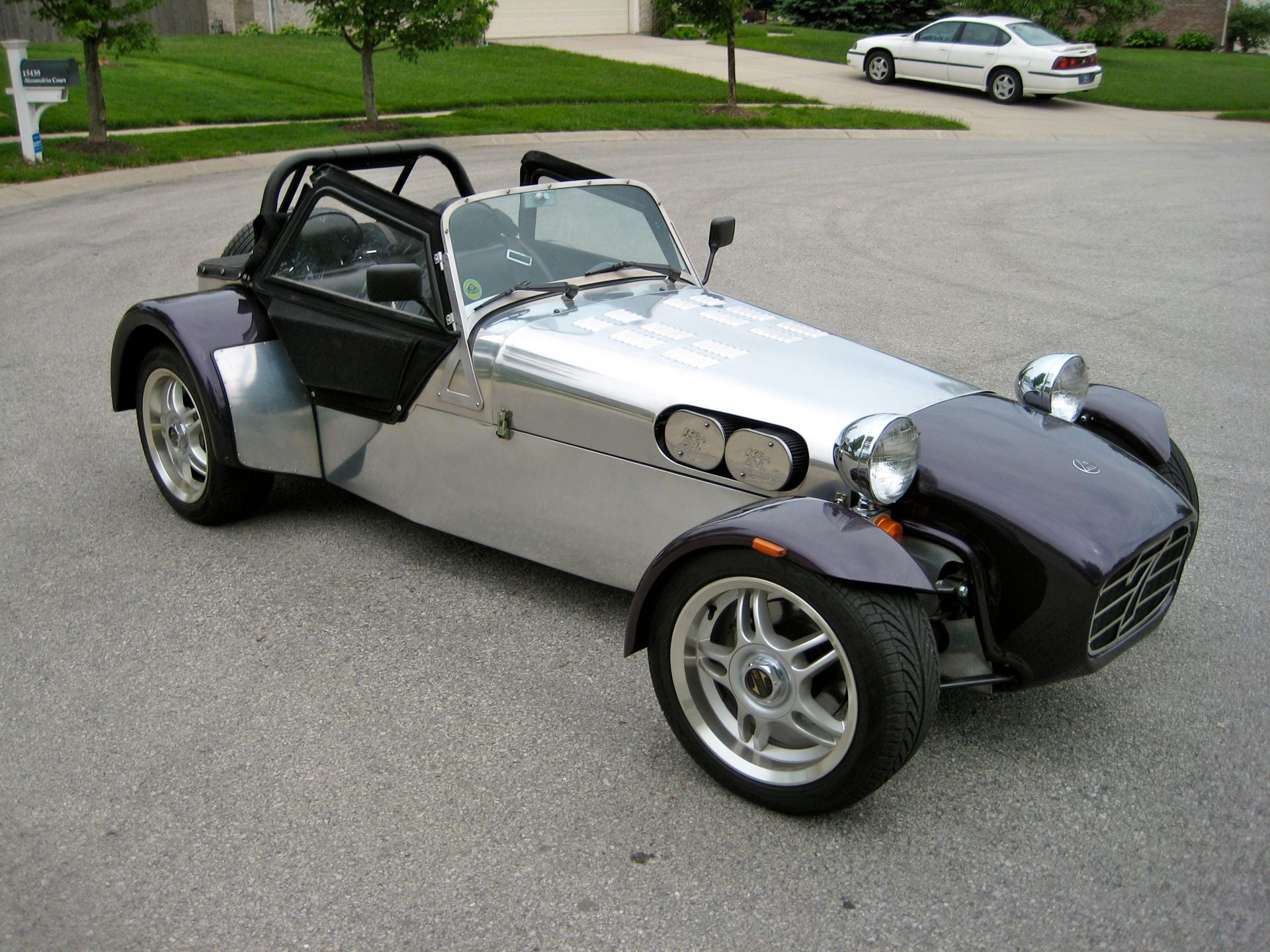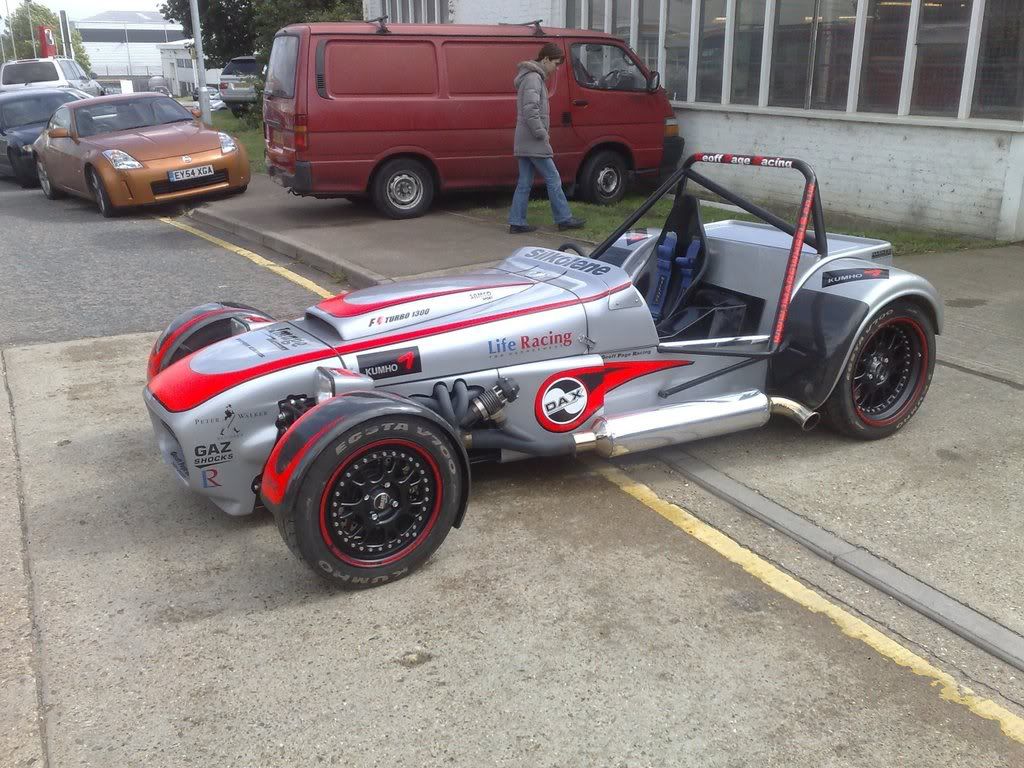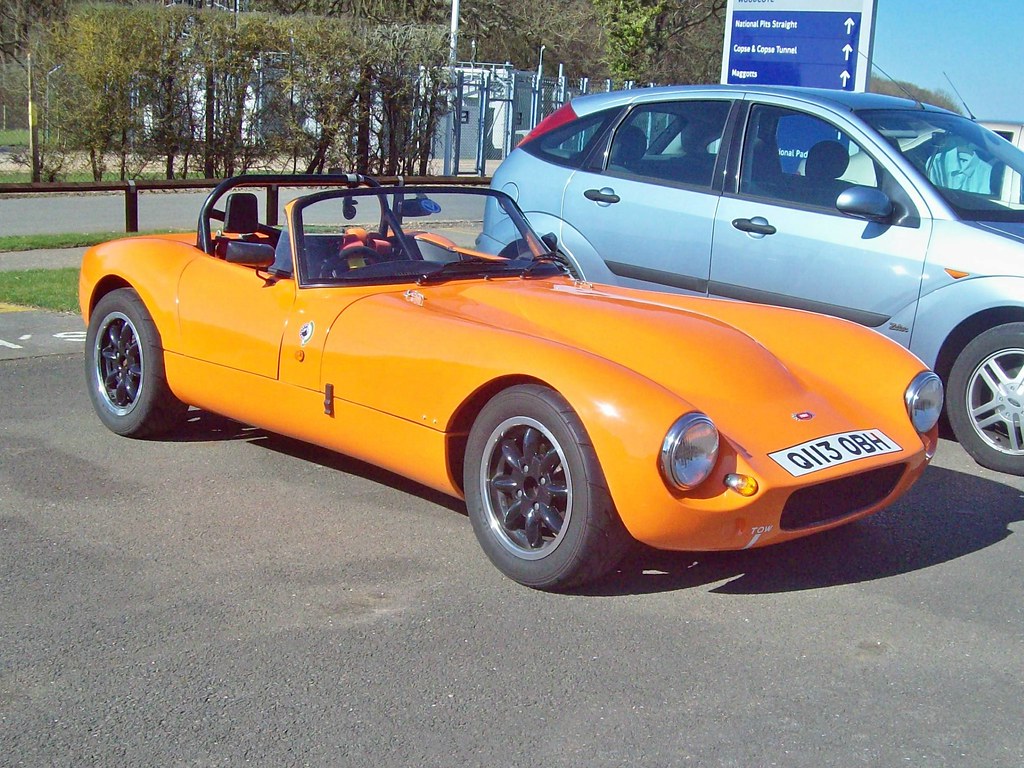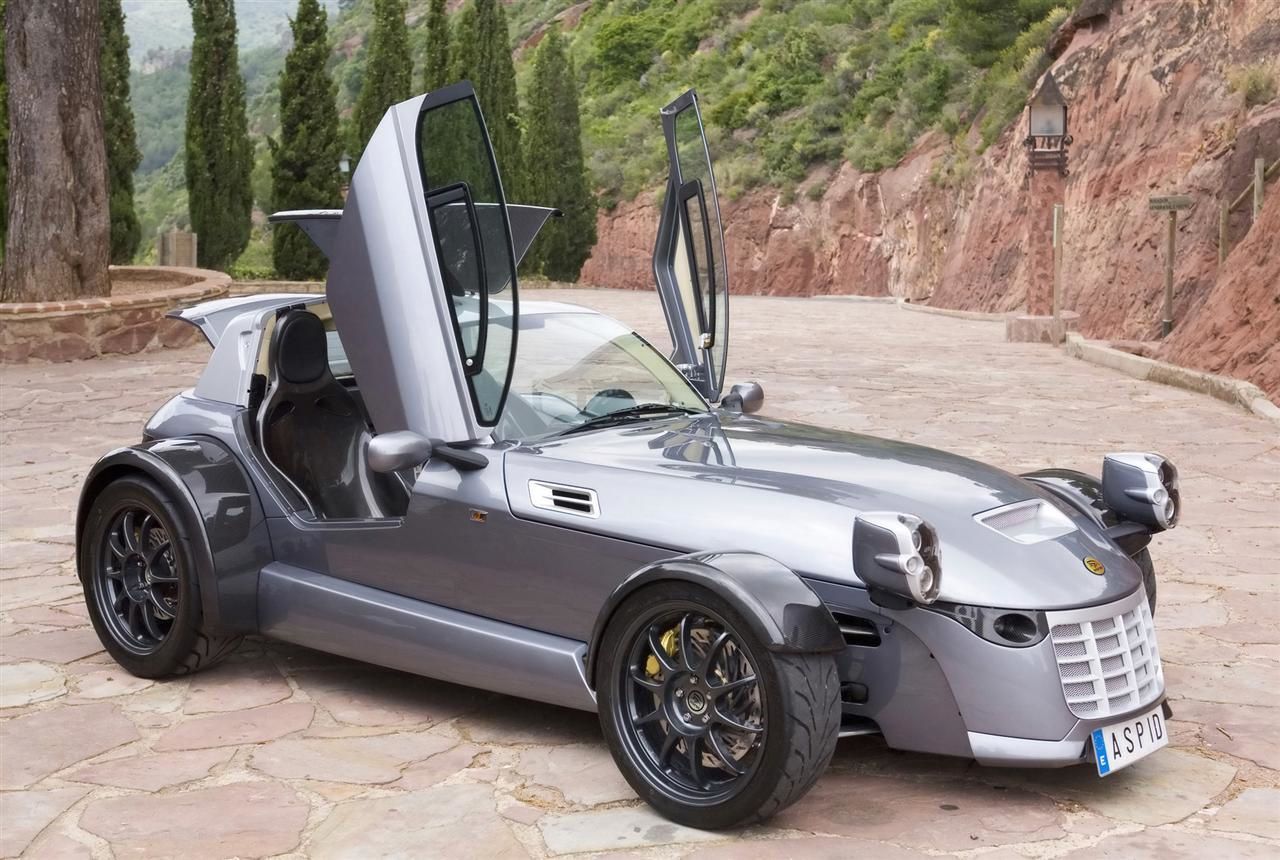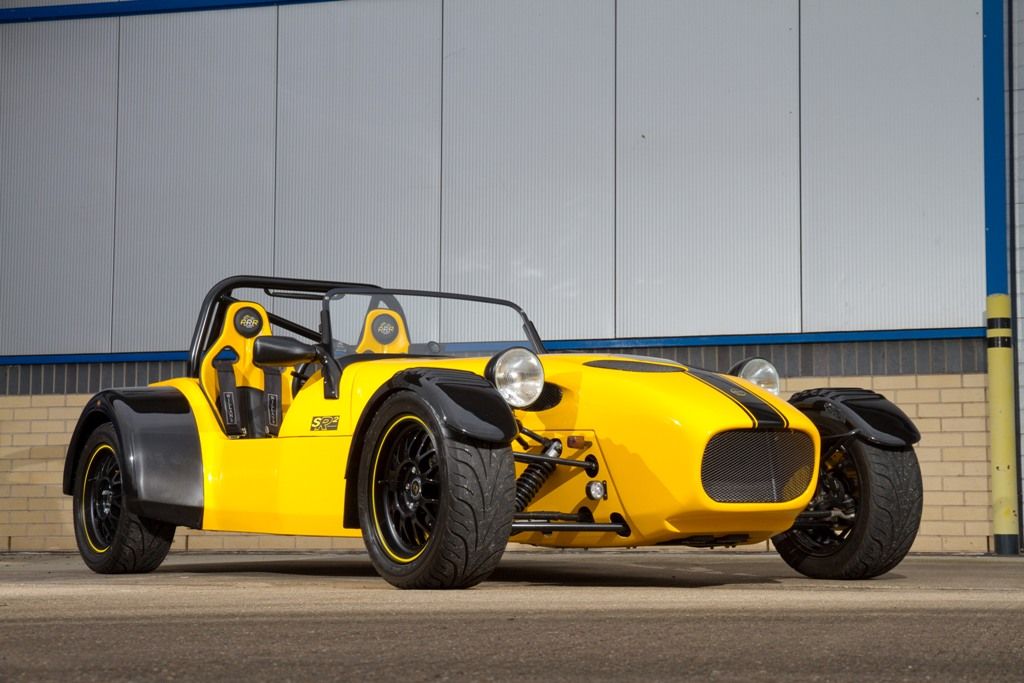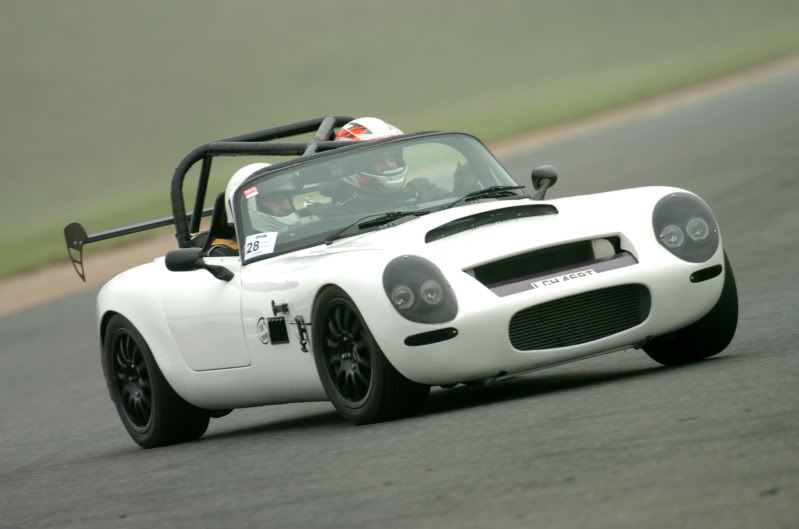Ultimate Seven Product
Discussion
Equus said:
But then you wouldn't, if they haven't announced it yet? 
But seriously, what's so spectacular about the 310? It's just a K-series SLR 300 with 40kg's more weight?
You may be right there mate 
But seriously, what's so spectacular about the 310? It's just a K-series SLR 300 with 40kg's more weight?

But we saw the 620R being developed with test drives of the development car and the factory racing one with the CSCC while developing it.
Equus said:
Caterham's problem is that they've never been a design and engineering-led company like Lotus. They were gifted an obsolete design and have done an adequate but unexceptional job of developing it (though some of their solutions have been plain clumsy, truth be told), while all around them the world has moved on and the niche for their product has started to dwindle.
justleanitupabit said:
I see others have tackled the rest of this post, I will point out that Caterham (Graham Nearn) was 'gifted' nothing.
As I understand it, the car they actually bought the manufacturing rights to was the S4... the intention was that S3, 'package' was thrown in as spares and servicing rights, though of course Lotus didn't much care by that stage... they just wanted rid of a car that no longer fitted the 'junior supercar' image that Chapman was trying to pursue.Equus said:
Since Caterham have built a business on parasitising Lotus' reputation, perhaps they might draw some inspiration from other Lotus sports racers and/or the early concepts work that Lotus did on the 'step-in car' that ultimately grew doors and became the Elise, and go mid-engined:
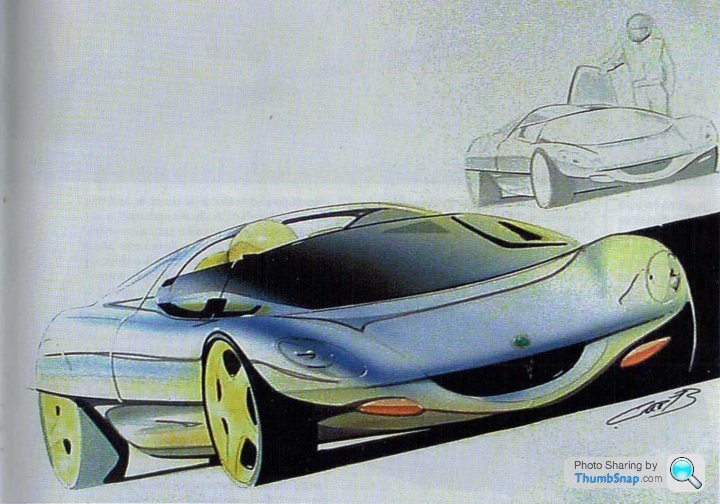
Lotus couldn't make such a minimalist mid-engined car work because they had to comply with full EU Type Approval, but Caterham only has IVA or LVTA to deal with, so they can do something more extreme.
I can't see mid-engined being either technically or commercially the route to go. Do that and you are competing with other similar cars. While a mid engine has advantages for a single seat race car - aero and traction in particular - on a road car it's far from clear. If you want balance and a car with adjustable, forgiving handling - and I've driven nothing better than a 7 in that regard, a mid FRONT engined car has advantages. It's much easier to make a front engined car narrow too. So I can see one of the USPs of the 7 is that it is front engined. Another is that it is (mostly) NA in an increasingly turbo world. That route is likely (legislation permitting) to yield a continuing niche market, which the (unrivalled) race series will continue to bolster. Certainly the long waiting lists (9 months?) don't suggest any falling of demand - more the reverse.
Lotus couldn't make such a minimalist mid-engined car work because they had to comply with full EU Type Approval, but Caterham only has IVA or LVTA to deal with, so they can do something more extreme.
That's not to say the major aero advantages shouldn't be sought, or that Colin Chapman's mantra of "adding lightness" shouldn't still be fundamental to their DNA.
Equus said:
Pdelamare said:
It was about the 310 model, wasn't it?
No, surely not?Graham MacDonald said:
...our motorsport programme has revealed something that we genuinely think could result in the ultimate Seven product. The engineering guys are positively giddy about this...
Marketing hyperbole aside, can we seriously imagine he was talking about the 310?Of course he was. That's it, the 310.
As you were.............
Yes but they are not produced in anything like the same numbers, and some are in a completely different price bracket. There have always been lots of players in the kit car field, but very few have ever produced cars in the hundreds as Caterham do. So they are not - in commercial terms - competitors to Caterham. Of course Ginetta or Westfield or one or two others could overtake Caterham - but there's been no real sign of that to date.
I don't like to sound like too much of an apologist for Caterham but they really cannot win can they? We keyboard experts queued up to tell them how wrong they were in exploring new models like the SP 300, Aero Seven etc , not to mention the ill-fated F1 adventure and we all said 'stick to what you know' .
So that is sort of exactly what they did and now we are seeing refinements and developments on the Seven theme. Cue another tirade of criticism for daring to do what so many felt they should do and lots of gratuitous suggestions about aero improvement etc , as well as an outrage about their marketing people using a bit of salesmanship in promoting the latest model... Fancy that eh, a bit of hype in an advert ('The Ultimate Driving Machine'- hmm - M1 maybe but 1602 ? Nah )?
All Caterham are doing is pushing a new variant which is an evolution of every other Seven which preceded it- and which happens to epitomise what many of us think a Seven should be, It's outrageous isn't it ?
So that is sort of exactly what they did and now we are seeing refinements and developments on the Seven theme. Cue another tirade of criticism for daring to do what so many felt they should do and lots of gratuitous suggestions about aero improvement etc , as well as an outrage about their marketing people using a bit of salesmanship in promoting the latest model... Fancy that eh, a bit of hype in an advert ('The Ultimate Driving Machine'- hmm - M1 maybe but 1602 ? Nah )?
All Caterham are doing is pushing a new variant which is an evolution of every other Seven which preceded it- and which happens to epitomise what many of us think a Seven should be, It's outrageous isn't it ?
bcr5784 said:
Yes but they are not produced in anything like the same numbers,.
Some are; Westfield's production figures have declined somewhat, but are still not so very far from Caterham's. GBS, MK, Birkin, MNR and RAW all produce a good number of cars each year, all providing an alternative to Caterham (at lower cost) and eroding its market.
Remember that Caterham themselves have only ever produced a few hundred cars per year, so there's not much of a market for them to dominate, and it can't stand much erosion.
coppice said:
I don't like to sound like too much of an apologist for Caterham but they really cannot win can they?
The short answer is no, they can't.Whereas Lotus (for example) built its reputation on innovation, Caterham has built its reputation on standing still. That's ultimately going to be a recipe for disaster for any business... there's no other way it can pan out.
Having said that, Morgan appears to be making a good effort at transforming itself - steadily and by means of sound strategy, rather than by the random and (largely) ill-advised stabs in various unconnected directions that Caterham have taken, thus far.
coppice said:
I don't like to sound like too much of an apologist for Caterham but they really cannot win can they? We keyboard experts queued up to tell them how wrong they were in exploring new models like the SP 300, Aero Seven etc , not to mention the ill-fated F1 adventure and we all said 'stick to what you know' .
So that is sort of exactly what they did and now we are seeing refinements and developments on the Seven theme. Cue another tirade of criticism for daring to do what so many felt they should do and lots of gratuitous suggestions about aero improvement etc , as well as an outrage about their marketing people using a bit of salesmanship in promoting the latest model... Fancy that eh, a bit of hype in an advert ('The Ultimate Driving Machine'- hmm - M1 maybe but 1602 ? Nah )?
All Caterham are doing is pushing a new variant which is an evolution of every other Seven which preceded it- and which happens to epitomise what many of us think a Seven should be, It's outrageous isn't it ?
So that is sort of exactly what they did and now we are seeing refinements and developments on the Seven theme. Cue another tirade of criticism for daring to do what so many felt they should do and lots of gratuitous suggestions about aero improvement etc , as well as an outrage about their marketing people using a bit of salesmanship in promoting the latest model... Fancy that eh, a bit of hype in an advert ('The Ultimate Driving Machine'- hmm - M1 maybe but 1602 ? Nah )?
All Caterham are doing is pushing a new variant which is an evolution of every other Seven which preceded it- and which happens to epitomise what many of us think a Seven should be, It's outrageous isn't it ?
Think you make a very good point and I'm quite happy with the 7 as it is.
But I do think that proclaiming a 17 Bhp increase on a current model as 'the ultimate' product is way OTT.
Equus said:
Whereas Lotus (for example) built its reputation on innovation, Caterham has built its reputation on standing still. That's ultimately going to be a recipe for disaster for any business... there's no other way it can pan out.
Well , history will be the judge of that and the Seven has somehow managed to blunder its way along for 43 years as Caterham and 59 years as the Seven itself . But standing still- I don't think so- walking slowly but purposefully is more like I'd suggest. When the Seven was acquired by Caterham it had an 85bhp X Flow and a live axle. And now we have De Dions and 300bhp plus - many times more than the Seven started off with.(At 40bhp ) . Bit like those chaps in Stuttgart really...if on a cottage industry scale. Frankly I really don't see what all the angsting is about - what do they want ? Caterham to make something else (so they stop being Caterham) or staying as they are and going bust ? CVue dancing in teh street and a chorus of ' I told you so's ?'
coppice said:
When the Seven was acquired by Caterham it had an 85bhp X Flow and a live axle. And now we have De Dions and 300bhp plus - many times more than the Seven started off with.(At 40bhp ).
Point of order, but the De Dion was hardly a Caterham innovation: there had been examples of Lotus-built Sevens (and even Six's) with de Dions, going back almost to prehistory - they just never productionised it as an option because of cost. And the de Dion is actually a heavily compromised design, with current levels of tyre grip, hence the need to cobble-on additional Watts linkages to brace it (a bodge that must have Chapman spinning in his grave, considering the amount of fuss he made over a single extra link being added to the Esprit's suspension!). Westfield showed them the way, with a proper IRS, but God knows it took them long enough to follow, with the CSR.
Similarly, the Seven 'started out' with other, more advanced engine options being available from the outset (the Climax series, for example)... they just didn't make much sense as fitment on a car that was supposed to be the 'budget' version of the Eleven: even back in the 1950's, Lotus and its customers recognised that there was little sense in throwing expensive engines at the brick wall of the Seven's aerodynamics, when a low-drag option was available to exploit them properly.
coppice said:
what do they want ? Caterham to make something else ...or staying as they are...
They can do both. How about sufficient progressive and structured diversification to survive and keep pace with changing markets and legislation, whilst continuing to produce their traditional models for those that want them?
Once again, I'd observe that Morgan has shown them the way... they only have to follow. They're good at that.

Equus said:
Point of order, but the De Dion was hardly a Caterham innovation: there had been examples of Lotus-built Sevens (and even Six's) with de Dions, going back almost to prehistory - they just never productionised it as an option because of cost.
And the de Dion is actually a heavily compromised design, with current levels of tyre grip, hence the need to cobble-on additional Watts linkages to brace it (a bodge that must have Chapman spinning in his grave, considering the amount of fuss he made over a single extra link being added to the Esprit's suspension!). Westfield showed them the way, with a proper IRS, but God knows it took them long enough to follow, with the CSR.
I'd disagree about de Dion. While IRS has advantages in unsprung weight and ultimate lateral grip - a De Dion gives better traction and, because there is no camber change, is more predictable. I think you miss the point about Watts linkages - they are put in to prevent the bump steer inherent in a Panhard rod (laterally) and trailing arms (longitudinally) - nothing to do with rigidity. Actually the ones used instead of trailing arms are not perfect - the rear arm is shorter than the front so it isn't geometrically pure. And the de Dion is actually a heavily compromised design, with current levels of tyre grip, hence the need to cobble-on additional Watts linkages to brace it (a bodge that must have Chapman spinning in his grave, considering the amount of fuss he made over a single extra link being added to the Esprit's suspension!). Westfield showed them the way, with a proper IRS, but God knows it took them long enough to follow, with the CSR.
bcr5784 said:
I'd disagree about de Dion. While IRS has advantages in unsprung weight and ultimate lateral grip - a De Dion gives better traction and, because there is no camber change, is more predictable.
DeDion gives better traction on perfectly smooth surfaces. In reality, the higher unsprung weight and the fact that a bump at one wheel is partially transmitted to the other more than negates any benefit.If you don't agree with this, then ask yourself why no modern race car (or proper, high performance road car, for that matter) uses a deDion.

Even Caterham themselves acknowledged at the time they introduced it that proper IRS would have been better, but said that they felt that (at the time) they didn't have the resources to design a proper IRS system. Obviously, they've now remedied that with the CSR.
bcr5784 said:
I think you miss the point about Watts linkages - they are put in to prevent the bump steer inherent in a Panhard rod (laterally) and trailing arms (longitudinally) - nothing to do with rigidity. Actually the ones used instead of trailing arms are not perfect - the rear arm is shorter than the front so it isn't geometrically pure.
Not true. They are put in to prevent deflection tramp of the deDion tube, caused by it having the lower a-frame pickup in the centre and the upper trailing arm outboard. Difficult to describe on here, without sketches, but basically flex in the deDion tube (and its bushes) can allow the hub to swing forwards and backwards to some degree with this arrangement, since it is only restrained at the top.
The upper trailing arm (which is retained, of course) still describes an arc which causes bump steer. I've not actually checked the geometry and measurements, but common sense suggests that the asymmetry in the Watts link is deliberate, to match this and so avoid binding.
Equus said:
bcr5784 said:
I'd disagree about de Dion. While IRS has advantages in unsprung weight and ultimate lateral grip - a De Dion gives better traction and, because there is no camber change, is more predictable.
DeDion gives better traction on perfectly smooth surfaces. In reality, the higher unsprung weight and the fact that a bump at one wheel is partially transmitted to the other more than negates any benefit.If you don't agree with this, then ask yourself why no modern race car (or proper, high performance road car, for that matter) uses a deDion.

Even Caterham themselves acknowledged at the time they introduced it that proper IRS would have been better, but said that they felt that (at the time) they didn't have the resources to design a proper IRS system. Obviously, they've now remedied that with the CSR.
bcr5784 said:
I think you miss the point about Watts linkages - they are put in to prevent the bump steer inherent in a Panhard rod (laterally) and trailing arms (longitudinally) - nothing to do with rigidity. Actually the ones used instead of trailing arms are not perfect - the rear arm is shorter than the front so it isn't geometrically pure.
Not true. They are put in to prevent deflection tramp of the deDion tube, caused by it having the lower a-frame pickup in the centre and the upper trailing arm outboard. Difficult to describe on here, without sketches, but basically flex in the deDion tube (and its bushes) can allow the hub to swing forwards and backwards to some degree with this arrangement, since it is only restrained at the top.
The upper trailing arm (which is retained, of course) still describes an arc which causes bump steer. I've not actually checked the geometry and measurements, but common sense suggests that the asymmetry in the Watts link is deliberate, to match this and so avoid binding.
Re De Dion you are simply wrong wrt bump steer. With a full set of Watts linkages on a de Dion tube the wheels move (practically speaking) vertically up and down on bump (that is the reason for having them) and when the axle squats or lifts under acceleration or braking again the wheels move vertically without lateral movement. See https://en.wikipedia.org/wiki/Watt%27s_linkage. Remember too that with IRS upward movement of one wheel produces lateral movement and hence a modicum of bump steer.
The reason the rear link is shorter than the front is simply that the rear link is attached to the rear of the chassis and you would have to make the car longer if the link was as long as it should otherwise be.
Why aren't they more commonly used? On mid engined race or road cars you generally cannot accommodate them because the gearbox gets in the way, and as I say ultimate lateral grip is (or can be) better with IRS. On road cars - de Dions take a lot of space if you have a decent amount of suspension travel (Remember the Rover 2000 - boot space was so compromised that the spare wheel was often mounted on the boot lid) . If you want forgiving predictable handling (the 7s forte?) De dions have a lot to recommend them.
That's not to say I'm anti IRS - just that I'm not convinced it would necessarily produce a better road car.
bcr5784 said:
With a full set of Watts linkages on a de Dion tube the wheels move (practically speaking) vertically up and down on bump
Indeed.But the Caterham (unlike the Sylva, an example of which I owned for many years) doesn't have a full set.
It still has an upper wishbone, and a lower A-frame, and it is these that dictate the arc that the axle still describes.
bcr5784 said:
The reason the rear link is shorter than the front is simply that the rear link is attached to the rear of the chassis and you would have to make the car longer if the link was as long as it should otherwise be.
But you can compensate by varying the symmetry of the middle link, if you wish to do so. There are other clever variations on the Watts link, if you need to overcome packaging problems, too - the WOBlink, for example.bcr5784 said:
Why aren't they more commonly used? On mid engined race or road cars you generally cannot accommodate them because the gearbox gets in the way

The 58 was reasonably quick, apparently, but not very pleasant to drive. It never raced, and given how unpleasant the Lotus 30 was to drive (but was still sold to customers), that suggests that it must have been pretty evil.
They also revisited the idea, post-78, for ground effect, as beam axles potentially offered a very stable aero platform and minimal interference with the flow through the ground effect tunnels. You can be sure that if it had shown any real promise, Chapman would have pursued it.
The gearbox isn't a problem with modern transverse racing boxes, of course.
Equus said:
bcr5784 said:
With a full set of Watts linkages on a de Dion tube the wheels move (practically speaking) vertically up and down on bump
Indeed.But the Caterham (unlike the Sylva, an example of which I owned for many years) doesn't have a full set.
It still has an upper wishbone, and a lower A-frame, and it is these that dictate the arc that the axle still describes.
bcr5784 said:
The reason the rear link is shorter than the front is simply that the rear link is attached to the rear of the chassis and you would have to make the car longer if the link was as long as it should otherwise be.
But you can compensate by varying the symmetry of the middle link, if you wish to do so. There are other clever variations on the Watts link, if you need to overcome packaging problems, too - the WOBlink, for example.bcr5784 said:
Why aren't they more commonly used? On mid engined race or road cars you generally cannot accommodate them because the gearbox gets in the way
That is what I'm talking about. Not sure what you are referring to as an "upper wishbone" there isn't one (not at the back anyway!)
However I come back to the main thrust - the De Dion works well, even without the Watts linkage (I think you'd have to be a real Westie enthusiast to argue that it handles better),
I am coming from the perspective that development often trumps theoretical advantage. Everyone would (I hope) agree that double wishbones are theoretically better than Macpherson struts - yet what is the best handling "sensible" sportscar - the Porsche Cayman (and the original Elan was damn good too). Semi trailing arms are a dreadful abortion - yet the Porsche 968 is very well regarded. Telescopic forks are a truly dreadful form of motorcycle suspension but have been developed to the point where all theoretically better arrangements have been tried and rejected even in MotoGP. I could go on.
If it ain't broke don't try and fix it - or at least fix the things that are broke (the worst drag factor of any production car allegedly) first. That is where they went wrong with CSR.
I'll end it there.
Sorry, ignore my reference to an upper wishbone - typing in a rush. I meant just the lower A-frame.
I think you're right that we'll never see eye to eye, though: I'm very much of the Lotus (dare I say British - we've a history of lading the way?) ethos of always innovating.
I loath the Porsche (dare I say [i]German[i] - Mercedes did the same with the low pivot swing axle, and Hitler with racial predjudice?) ethos of taking a really crap idea and then stubbornly developing it until it works reasonably well: it's complete anathema to me, and when applied to a former Lotus design doubly so.
Hence I'm also willing to admit that I don't have a whole lot of respect for a company that takes an innovative Lotus design but then lacks the ability to continue that tradition of innovation, and instead applies crude and clumsy 'bodges' to maintain its competitiveness, whilst all the time parasitising Lotus' reputation for marketing purposes.
I disagree that they went wrong with the suspension design on the CSR... it's not especially cutting-edge, but it's competent and has a reputation for excellent handling combined with very supple ride which is very Lotus-like indeed (I marvel at this on the original Elans - of which I've owned 4 over the years - the Europa and the Elise). But I agree that none of the rest of the car really moved the game forward by much.
We do agree on fixing the things that are worst broke, first, though - aerodynamics, as you say, and chassis stiffness:weight.
I think you're right that we'll never see eye to eye, though: I'm very much of the Lotus (dare I say British - we've a history of lading the way?) ethos of always innovating.
I loath the Porsche (dare I say [i]German[i] - Mercedes did the same with the low pivot swing axle, and Hitler with racial predjudice?) ethos of taking a really crap idea and then stubbornly developing it until it works reasonably well: it's complete anathema to me, and when applied to a former Lotus design doubly so.
Hence I'm also willing to admit that I don't have a whole lot of respect for a company that takes an innovative Lotus design but then lacks the ability to continue that tradition of innovation, and instead applies crude and clumsy 'bodges' to maintain its competitiveness, whilst all the time parasitising Lotus' reputation for marketing purposes.
I disagree that they went wrong with the suspension design on the CSR... it's not especially cutting-edge, but it's competent and has a reputation for excellent handling combined with very supple ride which is very Lotus-like indeed (I marvel at this on the original Elans - of which I've owned 4 over the years - the Europa and the Elise). But I agree that none of the rest of the car really moved the game forward by much.
We do agree on fixing the things that are worst broke, first, though - aerodynamics, as you say, and chassis stiffness:weight.
Equus said:
Sorry, ignore my reference to an upper wishbone - typing in a rush. I meant just the lower A-frame.
I disagree that they went wrong with the suspension design on the CSR... it's not especially cutting-edge, but it's competent and has a reputation for excellent handling combined with very supple ride which is very Lotus-like indeed (I marvel at this on the original Elans - of which I've owned 4 over the years - the Europa and the Elise). But I agree that none of the rest of the car really moved the game forward by much.
We do agree on fixing the things that are worst broke, first, though - aerodynamics, as you say, and chassis stiffness:weight.
Just to clarify I don't think there is anything particularly wrong with the CSR suspension (or even the modest, but welcome, aero tweaks to give reductions in front end lift and high speed understeer) - just that that wasn't (in my view) the most sensible focus of Caterham's limited engineering resources from a technical point of view - or, has been demonstrated, from a marketing one.I disagree that they went wrong with the suspension design on the CSR... it's not especially cutting-edge, but it's competent and has a reputation for excellent handling combined with very supple ride which is very Lotus-like indeed (I marvel at this on the original Elans - of which I've owned 4 over the years - the Europa and the Elise). But I agree that none of the rest of the car really moved the game forward by much.
We do agree on fixing the things that are worst broke, first, though - aerodynamics, as you say, and chassis stiffness:weight.
Gassing Station | Caterham | Top of Page | What's New | My Stuff





